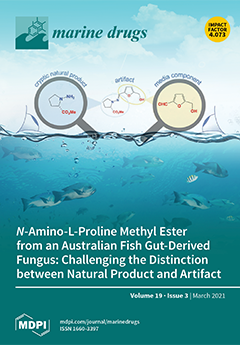Further investigation into a fish gut-derived fungus
Evlachovaea sp. CMB-F563, previously reported to produce the unprecedented Schiff base prolinimines A–B (
1–
2), revealed a new cryptic natural product,
N-amino-
l-proline methyl ester (
5)—only the second reported
[...] Read more.
Further investigation into a fish gut-derived fungus
Evlachovaea sp. CMB-F563, previously reported to produce the unprecedented Schiff base prolinimines A–B (
1–
2), revealed a new cryptic natural product,
N-amino-
l-proline methyl ester (
5)—only the second reported natural occurrence of an
N-amino-proline, and the first from a microbial source. To enable these investigations, we developed a highly sensitive analytical derivitization methodology, using 2,4-dinitrobenzaldehyde (2,4-DNB) to cause a rapid in situ transformation of
5 to the Schiff base
9, with the latter more readily detectable by UHPLC-DAD (400 nm) and HPLC-MS analyses. Moreover, we demonstrate that during cultivation
5 is retained in fungal mycelia, and it is only when solvent extraction disrupts mycelia that
5 is released to come in contact with the furans
7–
8 (which are themselves produced by thermal transformation of carbohydrates during media autoclaving prior to fungal inoculation). Significantly, on contact,
5 undergoes a spontaneous condensation with
7–
8 to yield the Schiff base prolinimines
1–
2, respectively. Observations made during this study prompted us to reflect on what it is to be a natural product (i.e.,
5), versus an artifact (i.e.,
1–
2), versus a media component (i.e.,
7–
8).
Full article






